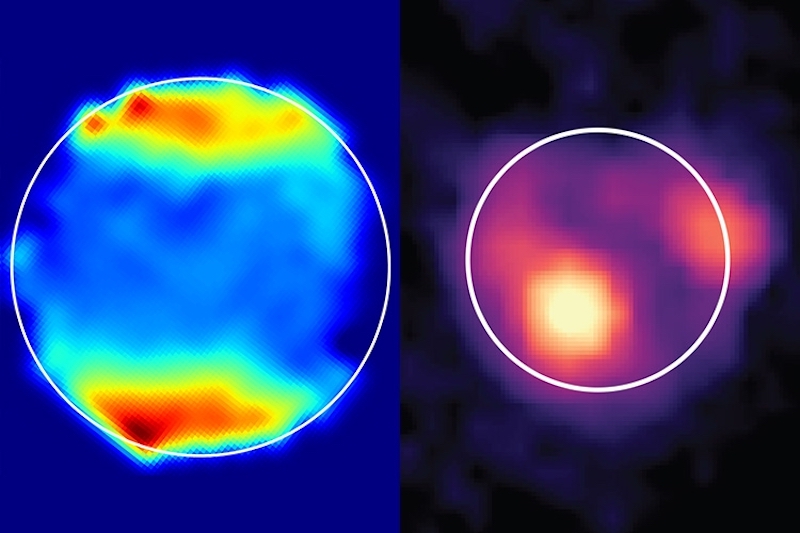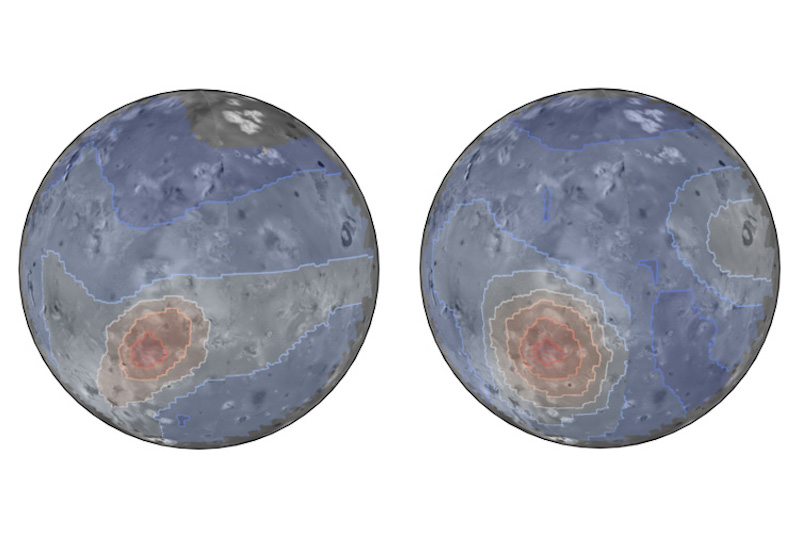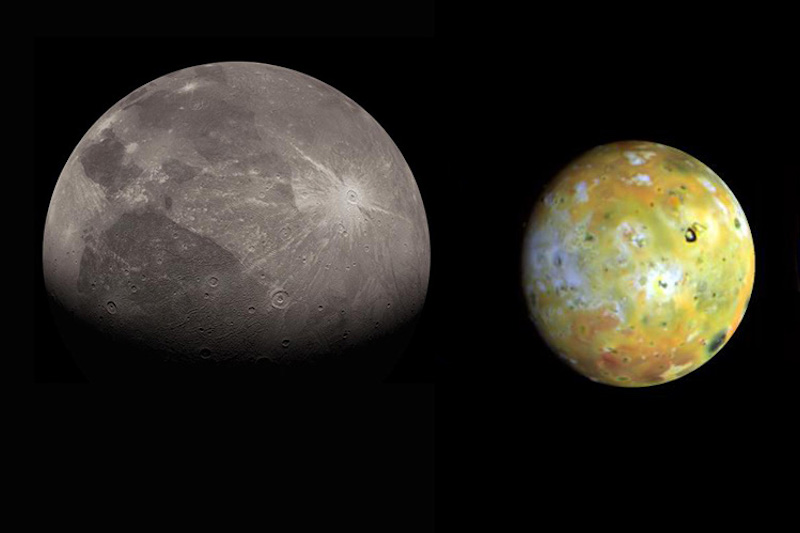
NASA’s James Webb Space Telescope has been returning extraordinary images of the deep universe, revealing familiar places in ways not seen before. But it has also set its sights on objects much closer to home, in our own solar system. And it just did it again!
Scientists released two new images from Webb, of two of Jupiter’s moons, Ganymede and Io, in late July 2023. The new images aren’t visual light, as we often see and as we’d see with our eyes. Instead, they are spectroscopic and infrared images. Researchers from the University of California, Berkeley and Cornell University announced their work on the new images on July 26, 2023.
The researchers have published two new peer-reviewed papers about the Webb observations. The first is in Science Advances (July 21, 2023) and the second is in JGR Planets (July 18, 2023).
New views of 2 of Jupiter’s moons from Webb telescope
Webb primarily studies distant stars and galaxies. But that doesn’t mean it can’t observe objects in the solar system, too. And indeed it has, including Jupiter, Saturn, Uranus, Neptune, Saturn’s ocean moon Enceladus and even comets.
Imke de Pater at the University of California, Berkeley, lead author of the Io paper, said:
This shows that we can do incredible science with the James Webb Space Telescope on solar system objects, even if the object is really very bright, like Jupiter, but also when you look at very faint things next to Jupiter.
Hydrogen peroxide at Ganymede’s poles
Samantha Trumbo at Cornell University led the Ganymede study. Webb used its Near-Infrared Spectrograph (NIRSpec) to study the moon’s north and south poles. It detected hydrogen peroxide (H2O2), which charged particles around Jupiter and Ganymede create when impacting the ice at the poles.
That process of creating the hydrogen peroxide is called radiolysis. The paper says:
Using observations obtained with JWST as part of the Early Release Science program exploring the Jupiter system, we report the discovery of hydrogen peroxide, a radiolysis product of water ice, specifically constrained to the high latitudes.
Ganymede’s magnetic field plays a role
The researchers say that this happens at Ganymede’s poles because the moon – unlike all other moons in the solar system – has a magnetic field. Trumbo said:
JWST revealing the presence of hydrogen peroxide at Ganymede’s poles shows for the first time that charged particles funneled along Ganymede’s magnetic field are preferentially altering the surface chemistry of its polar caps.
Trumbo added:
Just like how Earth’s magnetic field directs charged particles from the sun to the highest latitudes, causing the aurora, Ganymede’s magnetic field does the same thing to charged particles from Jupiter’s magnetosphere. Not only do these particles result in aurorae at Ganymede, as well, but they also impact the icy surface.
This is likely a really important and widespread process. These observations of Ganymede provide a key window to understand how such water radiolysis might drive chemistry on icy bodies throughout the outer solar system, including on neighboring Europa and Callisto (the fourth Galilean moon).
As de Pater also noted:
It helps to actually understand how this so-called radiolysis works and that, indeed, it works as people expected, based on lab experiments on Earth.
Ganymede is also the largest moon in the solar system.

Io’s active volcanoes
The second paper focuses on Io, the most volcanically active body in the solar system. On November 15, 2022, Webb observed ongoing eruptions, at two locations in particular. These were Loki Patera and Kanehekili Fluctus. In particular, the observations revealed an emission feature produced by “forbidden” transitions of the gas sulfur monoxide (SO) at Kanehekili Fluctus. Sulfur monoxide emissions are normally very weak and only last a short time. That happens after being “excited” in Io’s thin sulfur dioxide (SO2) atmosphere. In fact, the emissions are so hard to see that they can only be detected when Io is in Jupiter’s shadow. The sulfur dioxide freezes onto the moon’s surface, leaving only the monoxide, making it easier to detect.
As the paper explains:
We observed Io with JWST in November 2022 while the satellite was in Jupiter’s shadow, and glowing volcanoes show up without being (partially) obscured by reflected sunlight. We detected the volcanoes Loki Patera and Kanehekili Fluctus; the latter was exceptionally bright, and Loki Patera had likely entered a new brightening phase.
Sulfur dioxide linked to Io’s volcanoes for 1st time
So, Webb has provided the first conclusive evidence that links excited sulfur monoxide to volcanoes. The paper says:
This is the first time this emission has been seen above an active volcano, and suggests that such emissions are produced by SO molecules immediately upon leaving the vent.
De Pater also said:
These observations with Webb show for the first time that this excited SO actually did come from a volcano.
De Pater had actually found low levels of this excited sulfur monoxide before, using the W.M. Keck Observatory telescopes in Hawaii. At the time, however, the researchers were not able to link the hotspots to any known volcanoes. As a result, they theorized that there may be “stealth volcanoes” on Io. These would emit gas but not dust, making them harder to observe.
Webb is the first to show a link between excited sulfur monoxide and volcanoes on Io. But de Pater and her colleagues had hypothesized it before. She said:
The link between SO and volcanoes ties in with a hypothesis we had in 2002 to explain how we could see SO emission at all. The only way we could explain this emission is if the SO is excited in the volcanic vent at a temperature of 1,500 Kelvin [2,200 F or 1,200 C] or so, and that it comes out in this excited state, loses its photon within a few seconds, and that is the emission we see. So these observations are the first that actually show that this is the most likely mechanism of why we see that SO.

Loki Patera brightens for Webb telescope
When Webb saw the Loki Patera volcano, it was brighter than it had been in previous observations. Astronomers used Keck for those observations, in August and September 2022. As de Pater noted:
The Webb observations showed that actually eruptions had started, and that it was much brighter than what we had seen in September.
Webb’s next observations of Io will be sometime later this month. As before, the researchers will conduct it when Io is in Jupiter’s shadow.
Bottom line: NASA’s Webb Telescope has sent back spectroscopic and infrared views of 2 of Jupiter’s moons, Ganymede and Io, providing new insights into these distant worlds.











